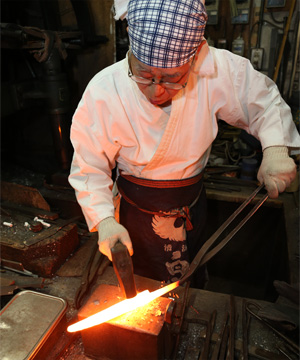
Originating in ancient times, Sakai Blades acquired a high reputation with its tobacco knives in the Edo period.

Tobacco knives and Sakai Blades
Sakai has many tumuli and ancient burial mounds, including the famous Mozu Tumuli Area. In the 5th century, blacksmiths gathered in Sakai to forge tools to be used to build these tumuli and ancient burial mounds, which is believed to have formed a foundation for the development of forging technology in Japan.
Sakai’s cutlery industry began to flourish in the 16th century, when tobacco was introduced into Japan from Portugal. Tobacco came to be cultivated in Japan, which created great demand for tobacco knives to chop tobacco leaves, and the manufacture of tobacco knives started in Sakai. Since tobacco knives made in Sakai were sharper than imported ones, the Tokugawa Shogunate allowed them to be stamped with “Sakai Kiwame” hallmarks in the Edo period (early 17th century to late 19th century), winning national fame.
In this way, Sakai Blades found root in tobacco knives, and the foundation of the industry was established at that time.
Sakai Traditional Blades, which have followed the distinguished traditional techniques, were designated as traditional crafts by the then Ministry of International Trade and Industry (now the Ministry of Economy, Trade and Industry) of Japan in March 1982. It is said that most professional-use blades are made in Sakai.
Also, in October 2007, Sakai Blades and Sakai Traditional Blades were registered as local community trademarks by the Japan Patent Office.

 072-227-1001
072-227-1001




